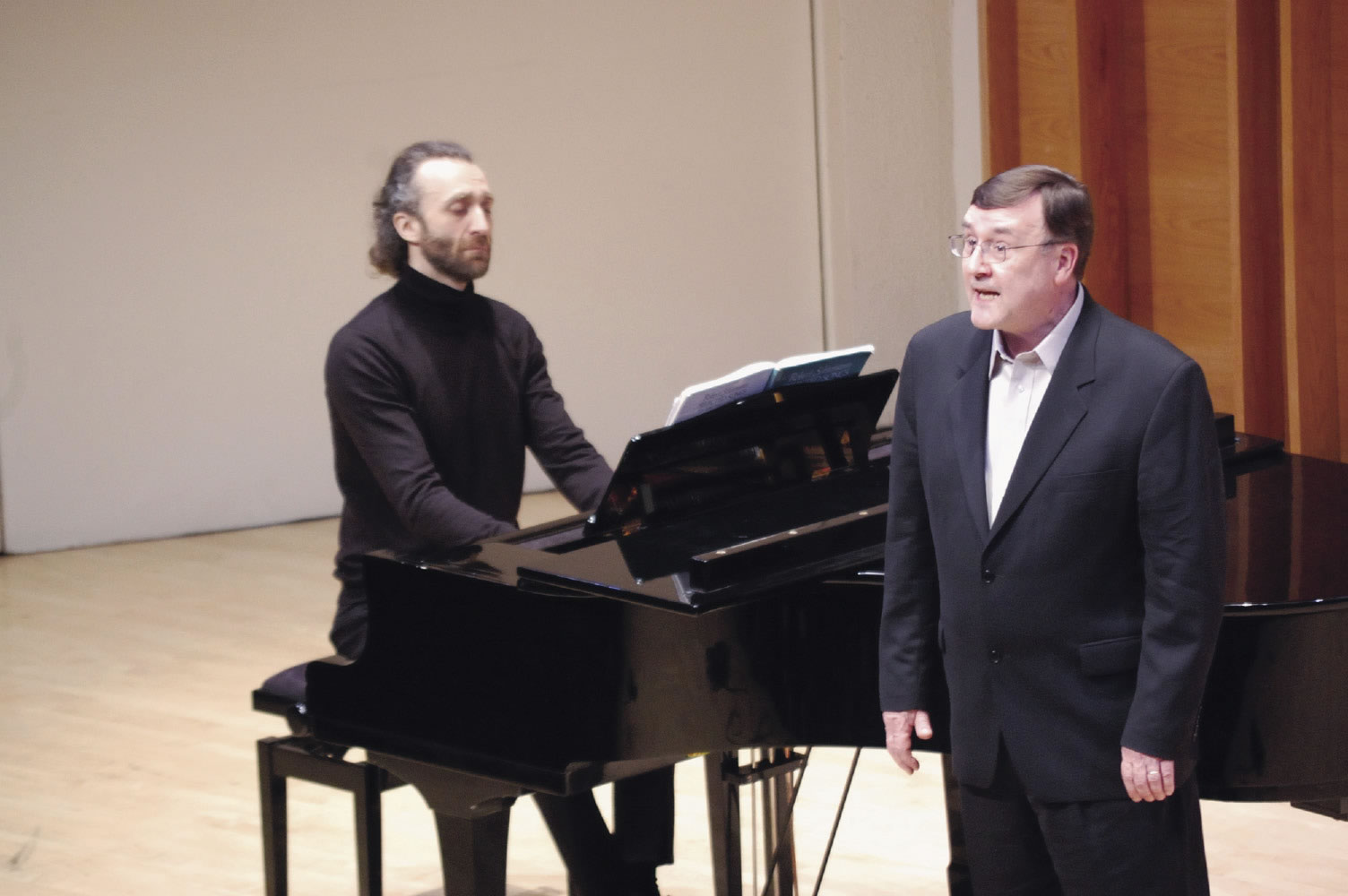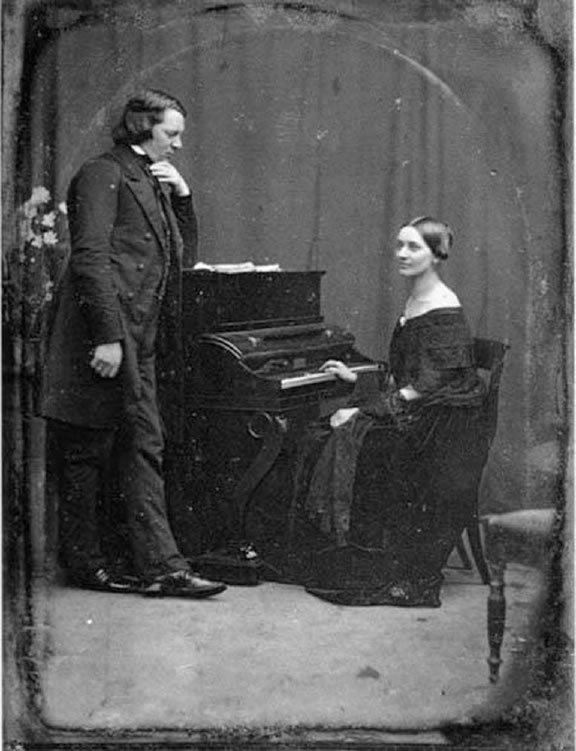The Meaning of Schumann’s Dichterliebe Song Cycle
by John Sigerson
May 2016
A PDF version of this article appears in the May 6, 2016 issue of Executive Intelligence Review and is re-published here with permission.
April 30, 2016 —Dennis Speed interviewed Schiller Institute Music Director John Sigerson today.
Dennis Speed: What is the role of the Schumann song cycle, Dichterliebe, in musical history? Why did you pick this piece to perform at the Schiller Institute’s Manhattan Conference of April 7?

EIRNS/Stuart Lewis
John Sigerson singing the Dichterliebe song cycle by Robert Schumann at the April 7 Schiller Institute Conference in New York, “Building a World Land-Bridge: Realizing Mankind’s True Humanity.” He is accompanied by Yegor Shevstov. |
John Sigerson: The Dichterliebe cycle is but one of the veritable cornucorpia of fruits of Robert Schumann’s Liederjahr, his “song year,” 1840. In the years leading up to this, Schumann had been composing primarily piano music; many of these compositions were collections of pieces that you could also call cycles without words. And indeed, in one of these he explicitly references the opening theme of one of the very first true song cycles, namely Beethoven’s An die ferne Geliebte (To the Distant Beloved), composed 24 years earlier. In the intervening time, Beethoven’s admirer Franz Schubert composed his two famous cycles, Die schöne Müllerin (The Beautiful Miller’s Daughter) and Winterreise (Winter’s Journey).
But what distinguishes Schumann’s Dichterliebe is the incredible unity of effect he achieves with only 16 songs, some of them less than a minute long. From the very first note of the first song—a C-sharp by the way—there’s an unbroken chain of poetic tension that doesn’t let up until the dying-out of the final note, which happens to be a D-flat—which is the same note on the keyboard, but with transformed significance, which pulls the entire cycle together.
When I was asked to sing for the conference, my thoughts went to a song cycle, and not just one or two songs, because I wanted to conclude the event not with relaxing entertainment, but with a real moral challenge, in keeping with the overall purpose of conference, namely to encourage participants to take political and moral responsibility for ensuring that mankind will not only survive as a species, but will have a future worth living. And in the Dichterliebe, the poet-singer must confront dark corners of his soul, before finally, in the last song, he is able to laugh at himself and, as he says explicitly, bury his “old songs”!
The Classical Outlook
Speed: The Dichterliebe is popularly referred to as exemplary of the Romantic School of poetic and musical composition. Why do you insist that the reality is quite the opposite?
Sigerson: Well, the first thing you have to understand, is that contrary to the history textbooks, music is not divided up into “periods” characterized by different “styles.” As Friedrich Schiller argued in his celebrated lecture on universal history, history is not merely a succession of periods or strings of events, but rather it is the history of millennia of struggle between, on the one side, man’s creative impulse, which distinguishes him absolutely from the beasts, and on the other side, those oligarchical institutions and individuals which insist that, on the contrary, man is essentially a beast, and that creativity must be checked whenever it threatens those institutions.

The poet Heinrich Heine composed the lyrics to Dichterliebe. |
Classical music is therefore not a style, but rather what Lyndon LaRouche has described as a “mind-set,” a Weltanschauung which gives absolute priority to human creativity as a vehicle for ennobling mankind, making him happier and more productive in discovering and mastering universal principles—principles of a developing, living universe.
The poet Heinrich Heine, who composed the lyrics to Dichterliebe, developed himself into a scholar of this mind-set, and in his major work, The History of Religion and Philosophy in Germany, he points out that the so-called “Romantic School” was in fact spawned by the philosopher Immanuel Kant, who argued that true creativity is essentially unknowable, and that humans are necessarily slaves to their own emotions, curbed only by social rules or maxims. In other words, man is essentially a trainable animal.
Schumann knew and loved not only Heine’s poetry, but also his political and philosophical writings, and any fair reading of both Heine’s poems and Schumann’s setting of them, will confirm that what is being discussed here, is nothing less than the underlying conflict I’ve just outlined.
Metaphor and Irony
Speed: Lyndon LaRouche has emphasized the polemical nature of this music, and that if the performance is properly done, and the audience is attentive, they will be moved to laughter or to deep irritation, but not left indifferent. Why?
Sigerson: Well, if it were merely polemical and nothing else, it wouldn’t be art. A more precise way to look at it, is from the standpoint of metaphor, that is, the ironical juxtaposition of elements which don’t seem to fit together “in the small,” but which create a motion—or perhaps better, an emotion—moving toward the discovery of a higher moral truth. And as Schiller insists, all this must clothed in beauty, because a certain suspension of the ugliness of the everyday world is necessary to elevate men’s souls.
This sort of metaphor is the principle underlying the counterpoint of J.S. Bach—which many of his contemporaries found so objectionable, and which is totally rejected by today’s so-called popular music. But not only that: Even the best music of Bach, Beethoven, Schubert, Schumann, and Brahms completely loses its “clout” if it is performed from any standpoint other than this. That is why so much purportedly Classical music performed today is so mind-numbingly boring.
In the Twentieth Century, one individual who knew this well, and got into lots of trouble for it, was the conductor and composer Wilhelm Furtwängler. For him, there was no separation between the developing universe, and the thinking, creative human mind. His music had such power, that even Adolf Hitler was terrified of him!
The Davidsbund

The Schumanns and their extended network of associates were all dedicated to music as the communication of profound ideas and principles. |
Speed: Schumann and Heine were friends, as were Felix Mendelssohn, his sister Fanny, and several others; they made up the artistic grouping Schumann called the Davidsbund [a reference to King David’s league that fought the Philistines —ed.]. What does the Dichterliebe as a project express about their outlook? Were there other works of this type, whether by Schumann and Heine, or by others?
Sigerson: Yes, this was an extended circle of friends and associates which, by the way, included the American System economist Friedrich List, who for some years was Schumann’s neighbor in Leipzig. Then young Johannes Brahms showed up one day on Schumann’s doorstep, and became part of the family, too. Along with Schumann’s wife Clara, they were all dedicated to music as essentially the communication of profound ideas and principles. They were resolutely opposed to music as mere novel effects, which the oligarchical circles of the day were promoting with their first “rock stars,” such as violin acrobat Niccolo Paganini and the piano-destroyer Franz Liszt.
As for other works, of course there are many! Another favorite of mine is Schumann’s very first song cycle, his Opus 24, also a series of settings of what Heine liked to term his “little poison poems.” One other poet whose creations Brahms often set to music was Eduard Mörike, who is less well known, but who is one of Helga Zepp-LaRouche’s favorites. One other thing that Brahms particularly liked to do, was to take a piece of inferior Romantic poetry, and to give it a totally Classical treatment. His Die schöne Magelone cycle is a good example of that.
And I might add, Furtwängler sometimes did the same thing, most famously with his 1938 recording of Tchaikovsky’s Symphony No. 6, called the “Pathétique.” The young Lyndon LaRouche, upon hearing this recording while stationed in India at the close of World War II, was stunned at how Furtwängler had managed to completely rid the work of its “soap opera” tendencies, and, through ironic juxtapositions, elevate it to the level of the Classical in Schiller’s sense.
Furtwängler as Composer

Schiller Institute
Any success I may have had so far in conveying Furtwängler’s mind-set, said Sigerson, has been more due to the overall social and political context of our performances. |
Speed: Furtwängler and his role in the Twentieth Century have defined your own approach to orchestral and choral conducting, and you have in the last two years done several performances, including the Mozart Requiem and Handel’s Messiah, in an attempt to convey “the Furtwängler principle” to larger audiences. But Furtwängler, as a pianist, also worked with singers of German Lieder, such as Dietrich Fischer-Dieskau and Elisabeth Schwarzkopf. Is his approach to working with an individual great singer the same, or different, than his approach to the orchestra? And what does that identity or difference in approach tell us about his unique approach to music?
Sigerson: Furtwängler considered himself to be a composer first and foremost. He composed Lieder, an oratorio, a symphonic concerto, violin sonatas, and three symphonies. He viewed his conducting as a necessary and important sideline, and it always pained him that the public put his conducting before his composing. His creative compositional impulse flowed equally into all his performance work, whether it was Lieder, opera, or symphonic works. For him, greatness in performance lay not in technical perfection, but rather in greatness of heart and mind and a oneness of moral purpose—which is why, for example, he preferred his “scrappy” Berlin Philharmonic to other more technically refined orchestras.
I must confess that any success I may have had so far in conveying Furtwängler’s mind-set has been more due to the overall social and political context of the performances you mentioned, and also to our well-prepared chorus, than to the orchestras, since we have never had the luxury of the extended rehearsal time required to bring all the instrumentalists into agreement with my intention. But I look forward to the happy day when that will be possible.
 A Manual on the Rudiments of Tuning and Registration: Click here for more information and to purchase. |
